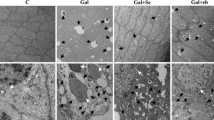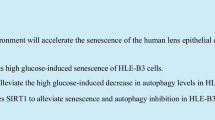Abstract
Lens epithelial cells are the metabolic unit of the lens and antioxidant enzymes are mainly concentrated here. The purpose of this study was to maintain human lens epithelial cells (HLEC) in culture and examine the status of antioxidant enzymes (glutathione peroxidase (GSHPx), catalase (CAT), glutathione-S-transferase (GST)), lipid peroxidation product malondialdehyde (MDA) and glutathione (GSH) levels in these cells under normal as well as hypergalactosemic (30 mM galactose) conditions. Further, effect of pyruvate, a physiological antioxidant has also been evaluated on these parameters. For conducting experiments, anterior capsule specimens obtained from fresh cadaver eyes from eye bank were cultured in Dulbecco's Modified Eagle's Medium (DMEM) supplemented with 20% fetal calf serum. Upon confluency, the cells were subcultured in three separate flasks containing DMEM alone (normal group), DMEM + 30 mM D-galactose (control group), DMEM + 30 mM D-galactose + 5 mM pyruvate (test group) and incubated for 24 or 72 h. These cells were observed under the phase contrast microscope for any morphological changes and harvested for the estimation of various antioxidant parameters. Our results show significant weakened antioxidant defense in HLEC when incubated in the presence of galactose as compared to normal. Addition of pyruvate significantly modulated levels of GSH, MDA, GSHPx, CAT and GST.
Similar content being viewed by others
References
Kuriyama H, Sasaki K, Fukuda M: Studies on diabetic cataract in rats induced by streptozotocin. Biochemical examination of rat lenses in relation to cataract stages. Ophthalmic Res 15: 191–197, 1983
Halliwell B, Cross CE: Oxygen derived species: Their relation to human disease and environmental stress. Environ Health Prospect 102(Suppl 10): 5–12, 1994
Obrosova IG, Fathallah L, Lang HJ: Interaction between osmotic and oxidative stress in diabetic precataractous lens. Biochem Pharmacol 58: 1945–1954, 1999
Verma SD: Scientific basis for the medical therapy of cataract by antioxidants. Am J Clin Nutr 53: 3355–3455, 1991
Lin LR, Reddy VN, Giblin FJ, Kador PF, Kinoshita JH: Polyol accumulation in cultured human lens epithelial cells. Exp Eye Res 52: 93-100, 1991
Zhao W, Devamanoharan PS, Henein M: Diabetes-induced biochemical changes in rat lens: Attenuation of cataractogeneis by pyruvate. Diabetes Obes Metab 2: 643–649, 2000
Reddy VN, Lin LR, Anita T, Huang QL: Crystallins and their synthesis in human lens epithelial cells in tissue culture. Exp Eye Res 47: 465-478, 1988
Bermbach G, Mayer U, Naumann G: Human lens epithelial cells in tissue culture. Exp Eye Res 52: 113–119, 1991
Moron MS, Depierre JW, Mannervik B: Level of glutathione, glutathione reductase and glutathione-S-transferase activity in rat lung and liver. Biochem Biophys Acta 82: 67–78, 1979
Ohkawa H, Ohishi N, Yagi K: Assay of lipid peroxide in animal tissue by thiobarbituric acid reaction. Anal Biochem 95: 351–58, 1979
Hebig H: Glutathione-S-transferase, the first enzymatic step in mercapturic acid formation. J Biochem 249: 7130–7134, 1974
Aebi H: Catalase. In: H.E. Bergmayer (ed). Methods of Enzymatic Analysis, vol 2. Chemic Acad Press Inc, Verlag, 1974, pp 45–51
Paglia DE, Valentine WN: Studies on the quantitative and qualitative characterization of erythrocyte peroxidase. J Lab and Clin Med 158: 345–354, 1967
Lowry OH, Rosebrough NJ, Farr AI, Randall RT: Protein measurements with the Folin phenol reagent. J Biol Chem 193: 265–275, 1951
Collier A, Small M: The role of polyol pathway in diabetes mellitus. J Hosp Med 45: 38–40, 1993
Wolff SP, Dean RT: Glucose autoxidation and protein modifications. The potential role of autoxidative glycosylation in diabetes. Biochem J 245: 243–250, 1985
Miyoshi EKN, Fukuda M, Akagi Y: Cataract formation through the polyol pathway is associated with free radical production. Exp Eye Res 68: 457–464, 1999
Varma SD, Schocket SS, Richards RD: Implication of aldose reductase in cataracts in human diabetes. Invest Opthalmol Vis Sci 18: 237–241, 1979
Nagata AM, Ahohman TC, Nishumura C, Drea MC, Robinson WG: Polyol and vacuole formation in cultured canine lens epithelial cells. Exp Eye Res 48: 667–677, 1989
Varma SD, Ramachandaran S, Devamanoharan PS: Prevention of oxidative damage to rat lens by pyruvate: Possible attenuation in vivo. Curr Eye Res 14: 643–648, 1995
Varma SD, Devamanoharan PS, Rutzen AR: Attenuation of galactose induced cataract by pyruvate. Free Radic Res 30: 253–263, 1999
Varma SD, Morris SM: Peroxide damage to eye lens in vitro: Prevention by pyruvate. Free Rad Res Commun 4: 283–290, 1988
Zhao W, Devamanoharan PS, Henein M: Diabetes induced biochemical changes in rat lens: Attenuation of cataractogenesis by pyruvate. Diabetes Obes Metab 2:165–174, 2000
Beyer-Mears A, Diecke FP, Mistry K: Effect of pyruvate on myo-inositol transport and polyol formation in diabetic cataract. Pharmacology 55: 78–86, 1997
Author information
Authors and Affiliations
Rights and permissions
About this article
Cite this article
Mohanty, I., Joshi, S., Trivedi, D. et al. Pyruvate modulates antioxidant status of cultured human lens epithelial cells under hypergalactosemic conditions. Mol Cell Biochem 238, 129–135 (2002). https://doi.org/10.1023/A:1019961922260
Issue Date:
DOI: https://doi.org/10.1023/A:1019961922260




